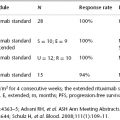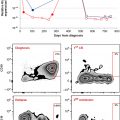Endocrine Malignancies
Ann W. Gramza
NIH/NCI Endocrine Oncology Branch, Bethesda, MD, USA
Case study 73.1 A 48-year-old female with MEN 2A and metastatic medullary thyroid cancer (MTC) is referred for consideration of systemic therapy. She is euthyroid and asymptomatic, and her calcitonin has been stable for the past year. Imaging studies reveal a 1.6 cm mediastinal lymph node and multiple subcentimeter pulmonary lesions. Her bone scan is negative. Several of the lesions have increased by 2–3 mm since imaging done 2 years prior.
1. What is the best course of management for this patient?
Perform an I-131 diagnostic scan to determine if I-131 is a treatment option. Repeat imaging studies and calcitonin in 6 months. Vandetanib Cabozantinib Increase levothyroxine for TSH suppression. Given the overall stability of this patient’s disease and lack of symptoms, the best course of management is to repeat her imaging and calcitonin in 6 months. If her disease has been stable for several years, it may be appropriate to image her yearly. Vandetanib and cabozantinib are both FDA approved for unresectable locally advanced or metastatic MTC that is progressing or symptomatic. I-131 and TSH suppression are treatment modalities for differentiated thyroid cancers such as papillary and follicular thyroid cancer.
2. Vandetanib, but not cabozantinib, improves overall survival for patients with metastatic medullary thyroid cancer?
Yes No Both of these tyrosine kinase inhibitors (TKIs) were approved for MTC based on improvements in progression-free survival. Neither drug has provided a complete response or improved overall survival. Both TKIs are associated with toxicities, which can be severe. Therefore, patients with metastatic MTC should be treated with a TKI only if they have progressive or symptomatic disease, such that the benefit of therapy has the potential to outweigh the risk. Cabozantinib and vandetanib have not been compared in a randomized trial; therefore, it is unknown which is the superior agent and which should be used as first-line therapy.
Case study 73.2 A 52-year-old man presents with Cushing’s syndrome is found to have an adrenal mass. An adrenalectomy reveals a 4.7 cm low-grade adrenocortical carcinoma with capsular invasion but negative margins, no invasion of adjacent organs or vessels, and no positive lymph nodes. There are no distant metastases.
1. What should be done next?
Adjuvant mitotane alone Adjuvant mitotane and external beam radiation to the adrenal fossa Adjuvant mitotane and streptozotocin External beam radiation to the adrenal fossa alone Observation with imaging and biomarkers in 3 months In this case, which presents a low-risk patient with stage I disease, most experts would recommend observation alone. There are several reports demonstrating the benefit of adjuvant mitotane for patients with resected stage I to III disease; however, none are prospective randomized clinical trials. The decision to treat with adjuvant mitotane is controversial, particularly for those with low-risk disease (low grade, small tumor, complete resection, etc.). Mitotane is associated with toxicities such as adrenal insufficiency, hypogonadism, and hypothyroidism, and the clear benefit for patients with low-risk disease is unknown. An international randomized phase III trial is currently underway for patients with low- and intermediate-risk disease to address this question.
Multiple Choice Questions
1. True or false? For patients with metastatic adrenocortical carcinoma (ACC) not amenable to radical surgical resection, systemic therapy with etoposide, doxorubicin, cisplatin, and mitotane (EDP-M) improves overall survival when compared to treatment with streptozocin and mitotane (Sz-M).
True False This question refers to the results of the largest prospective, randomized trial of patients with ACC, in which 304 patients were randomized to EDP-M or Sz-M. For first-line therapy, patients in the EDP-M arm had a higher response rate than those in the Sz-M arm (23.2% vs. 9.2%; P < 0.001) and longer median progression-free survival (5.0 months vs. 2.1 months; P < 0.001), with similar rates of adverse events. However, there was no statistically significant improvement in overall survival. Patients with disease progression received the alternate regimen as second-line therapy. The response to EDP-M as second-line therapy could have affected the overall survival analysis.
Case study 73.3 A 37-year-old woman has a fine needle aspiration of both a thyroid mass and lung nodule, and she is diagnosed with metastatic papillary thyroid cancer. She has approximately 15 bilateral pulmonary nodules, the largest of which is 0.6 cm.
1. What should be the first step in her management?
< div class='tao-gold-member'>







